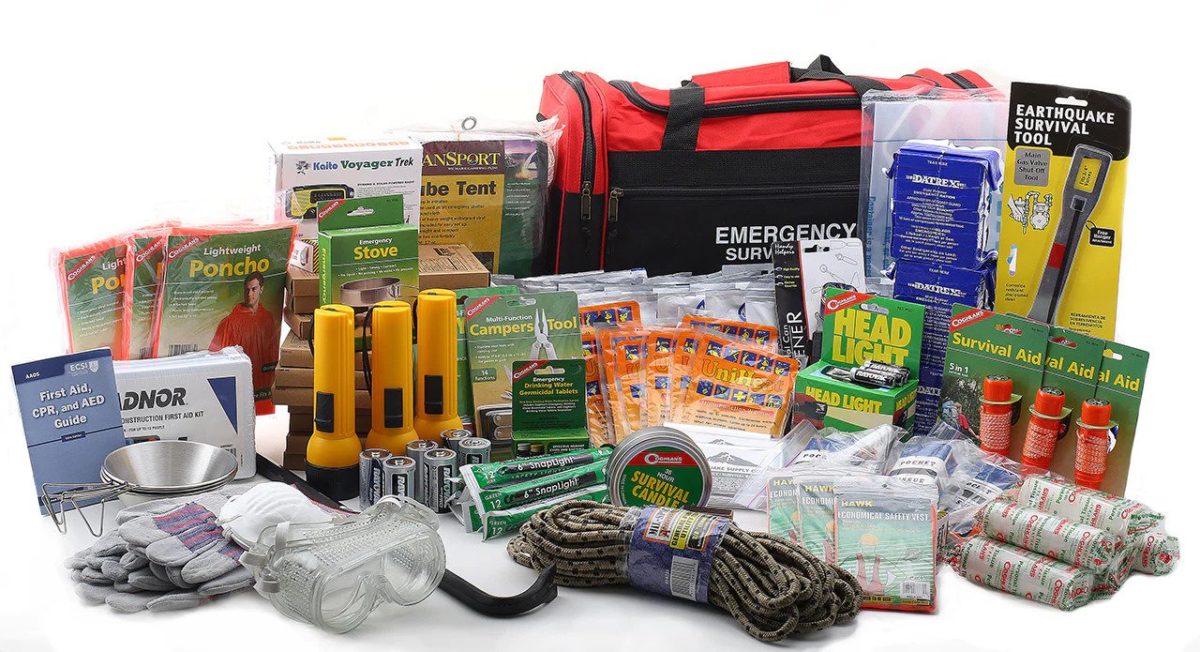
Preppers are really good at lots of things, and making “lists” is chief among them. Getting prepared and remaining prepared requires organization – that takes the making of lists, as well as with lists of lists – got to keep all of those lists recorded and updated too!
You absolutely do not want to be scrambling around to find survival gear and supplies AS the SHTF. The preps should be organized into specific survival kits, labeled, and placed in a storage space noted on the preparedness plan master diagram. All of the items each container stores should be placed onto a list that is printed off in hard copy form and stored electronically as well.
Do not forget the human component when making survival kit lists. When a doomsday disaster happens; everyone in our tribe (my favorite term for our mutual assistance group comprised of loved ones and prepping pals) knows exactly what to do both immediately and in the hours that follow the SHTF emergency – thanks to our individualized survival action lists.
Hurricane Survival Kit
If you live in or visit a hurricane-prone area; you should develop a survival kit that can get you through at least one week without aid from the outside world.
-
Water – When a hurricane hits; the power will go out and potable water will not likely be available for at least several days – or weeks if the storm is severe. You should store enough water to cover the one gallon per day per person general rule of thumb.
-
Generator and Fuel – Expert the power to go out and stay out for at least a week after a hurricane. Purchase a generator that runs on multiple fuel types and a solar generator for your survival kit when the prepping budget permits. Getting gasoline; diesel fuel; or propane will also be virtually impossible in the wake of a substantial storm.
-
Flashlights and Batteries – You simply cannot stockpile too many batteries or flashlights. Make sure to rotate your battery stockpile annually and check flashlights for signs of erosion. Solar yard lights can also be used as a cheap backup to flashlights and lanterns.
-
Emergency Radio – Having the capability to hear additional weather alerts and public notices will be extremely valuable both before the hurricane hits and after. Purchasing an emergency radio that can also run on solar and/or manual crank power will increase your chances of the device’s longevity during a disaster.
-
Water Purifiers – If you run out of stockpiled water; purifying any water you have access to will increase your chances of survival.
-
Long-Term Storage Food – You will need both enough shelf-stable food to survive at least a week without outside aid; and the means of preparing the food. Boiling water to pour into survival food packets will require both potable water and the ability to heat it; such as a rocket stove; outdoor campfire; camping stove; etc.
Bugout Bag Food Survival Kit
Your bugout bag, INCH bag, and the get-me-home bag must include long-term storage survival food to supplement your diet while attempting to hunt; forage; fish; barter; or scavenge additional food. Remaining strong and fit during an SHTF disaster will substantially increase your chances of survival.
Things to Consider When Selecting Shelf-Stable Food For Your Survival Kit
- Nutrients – The long-term survival food should have high carbohydrate protein and fat content. The carbohydrates will provide additional energy bursts and the proteins and fats will increase your caloric intake and help the stomach feel full.
- Calorie Count vs Weight – How much the long-term storage food weighs is just as important as the number of quality calories it contains. A can of beef stew, for example, would be an excellent choice because of the nutrient content, shelf life, and easy preparation of the meal, but the canned food will add a lot of weight to your bag and take up far more space than a survival food pouch containing the same type of entree. You want to select long-term storage food that provides as many calories as possible per ounce of container weight.
- Shelf Life – You must pay attention to the use-by date of the items placed in the bag carefully. Once again, compare the value of the food on both a caloric and comfort level to the weight it will add to your bag and the space it will require. The food survival food should have a shelf life of at least two years and a record kept of all perishable items in each survival kit so they can be rotated appropriately to avoid wasted money or illness if consumed. Energy bars; fruit bars; beef jerky and cheese sticks are lightweight. have a decent shelf life, and may provide a comfort food moral boost while taking up very little space and not adding any substantial weight to your bag.
EDC First Aid Survival Kit
Disaster can, will, and has; happened without warning. Your everyday carry first aid kit should be large enough to contain all the essential supplies you will need to tend to personal medical emergencies and to help your loved ones do the same – but small and lightweight enough to remain portable. If you or a member of your family takes medication on a daily basis, a pill container with at least a 3-day supply.
Types Of Emergency Medical Supplies For Your First Aid Survival Kit
-
Fever, Pain, and Infection Fighters – Sickness and injuries are commonplace now but will become more prevalent during either a short or long-term disaster. A simple infection of a small wound is easily treatable during normal circumstances but can become deadly quickly during an SHTF situation. Carry and rotate medications that will fight fever and reduce swelling as well as an ointment to deter infections.
-
Skin Irritations and Allergies – Seasonal and exposure allergies can become just crippling enough to thwart your survival efforts. If you or a member of your tribe suffers from insect sting allergies or seasonal allergies, make sure to pack and rotate the appropriate medications to treat and remedy medical emergencies that will arise if they are stung or exposed to an inciting insect, weather, or environmental conditions. Standard skin irritation gels and materials like aloe Vera gel, Benadryl, and calamine lotion should also be included in the first aid survival kit.
-
Life-Threatening Emergencies – A quick-clotting bandages, tourniquets, snake bite kits, and similar immediate aid medical devices should be the first supplies in the emergency survival kit and stored in an exterior zippered pouch for easy access.
-
Splints and Wraps – Being immobile during a disaster absolutely will not help your chances of surviving long enough to reach safety. Single-use ice and heat packs split, athletic wrap, and arm slings, to help you remain as functional as possible after becoming injured during an SHTF scenario. You can use your knife or hatchet to craft a crutch out of a tree branch to help keep you on your feet and walking after an injury and to make a more firm splinting device if necessary.
Earthquake Survival Kit
It is not only those Americans who live along a fault line who should be preparing for an earthquake. Nearly half of all residents in the United States live in an area at risk for a damaging earthquake, according to a report by the U.S. Geological Survey. Approximately 143 million citizens in the lower 48 states could be impacted by an earthquake. About 28 million of our fellow Americans live in regions where there is a “high” potential for a substantial earthquake and around 57 million citizens live in zones that have been deemed “moderate hazard” regions.
Top Earthquake Survival Kit Preps
- Water – FEMA preparedness experts recommend keeping enough water for every person in your family to survive for up to two weeks without outside assistance if water service is disrupted after an earthquake.
- Food – You should also stockpile enough food to last for two weeks per person. Preparing food will most likely have to take place by non-conventional or primitive means – outdoor cooking, solar cooking, camping stove, or oven.
- First Aid – An emergency medical kit larger than the EDC should be a top priority because you will be yourown first responder at least during the initial hours after a hurricane hits.
- Sanitation – If an earthquake rips through your region, it could take out not only the power grid and water utilities but the sewage utilities and sanitation services as well. The disease spreads rapidly during an SHTF situation and being exposed to raw human waste will increase your exposure to infection. Purchase a composting toilet and lime to fill its collection basin and wear gloves when regularly dumping out the waste.
Related: Is It Illegal to Harvest Rainwater in Your State?
Power Grid Down Survival Kit
Prepping for a downed power grid will help your family survive any type of disaster – because the lights will go out for an undetermined amount of time during nearly any SHTF scenario. All of the items from the survival kits above will be necessary to live through a power grid blackout, but they are not the only preps you will need to protect and care for your home and family.
Survival Kit Essential During A Power Grid Down Disaster
-
Currency – You will not be able to use your credit card or hit the ATM after a power grid blackout. If the power grid failure is massive and long-term or part of the domino effect of another SHTF disaster, the dollar will soon become nothing more than a worthless piece of paper anyway. Stockpile precious metals and gems, essential bartering materials like water, batteries, over-the-counter medications, and cans of food for trading with others to meet any needs that arise during the disaster.
-
Marauding Hordes – Protecting your loved ones and your preps will fall on your own shoulders during a power grid down disaster – for either the short or long term. Police officers will be overwhelmed with emergency calls and they too will eventually lack the fuel to keep their cruisers on the road and their emergency radios charged. Stockpiling guns and ammo are essential. If you currently live somewhere that infringes on the Second Amendment and your ability to possess an EDC firearm – move now, before it is too late, and buy all available and legal self-defense gear to better protect yourself until the relocation is complete!
-
Communications – Keeping in contact with the outside world will help you stay informed about not just public alert messages from the government, but open the lines of communication with other Americans so you are aware of a disease is sweeping the region and how close violent civil unrest is to your home and family. Store your emergency 2-way radios and extra batteries in a Faraday cage to harden them against EMPs and solar flares.
Survival Bags
Even if you are planning on bugging in at your survival retreat, you should also prepare for first getting there safely and being ready to flee at a moment’s notice if the situation warrants. Being focused only on being at home when the SHTF disaster occurs and remaining there, will quite possibly get you killed.
There are several different types of survival bags. Bugout bags or go bags, car bugout bags, get-home bags, and INCH (I’m Never Coming Home) bags.
Bugout Bags
A bugout bag (or BoB) is a portable rucksack or kit that holds enough gear and supplies to help you survive for at least 72 hours after disaster strikes. These individualized emergency bags are also often referred to as “go bags.”
Get Home Bags
This type of survival kit holds enough emergency supplies to help you get from where you are to your home or prepper retreat. It usually holds about 24 hours of supplies like food, water, cookware, and fire starters.
INCH Bags
An INCH bag is a bugout bag on steroids. It contains all of your most essential and critically important preparedness gear. This type of survival kit is larger and heavier than a bugout bag because it holds all of the supplies and tools necessary to help sustain your life indefinitely. An INCH bag should be kept by the door so you can grab it and RUN if the marauding hordes are about to overwhelm your prepper retreat, fire is moving in your direction, or some other situation beyond your control happens after the SHTF.
Car Bugout Bags
Sometimes this type of survival kit is not even a bag at all. Plastic totes or pickup truck bed tool storage containers are often used as car Bobs. These kits are not designed to be portable and contain heavy gear like tents, multiple types of tools, additional food, water, and first aid supplies, a rifle, fishing gear, a camping stove, and even equipment that is powered by the vehicle’s cigarette lighter. The survival kit supplies will allow you to set up a base camp near the vehicle as you travel to your intended destination, stay overnight in the vehicle itself, or fix small to medium mechanical problems that the vehicle may have while getting back home or the prepper retreat.
A quality constructed and filled bugout bag stored in your vehicle or place of work will be both your first and last line of defense against the impact and aftermath of the disaster. Your bag and what it contains could quite easily be the only thing you have to rely upon when the apocalyptic scenario unfolds.
The quality of each style of survival kit bag is every bit as important as the survival gear that will be stowed inside.
-
Cost – When buying a bugout bag and an INCH bag you must look for quality over cost – this is not a time to pinch pennies. If the bag is cheap, it may also have been constructed poorly and will not be able to stand up to rugged wear and tear. Test the zippers and the straps on the bags and make sure they are constructed durably. Purchase a small hand-sewing kit, nylon straps, and Velcro to pack in the bags so they can be repaired if needed.
-
Fit – Try the bag on just like you would do if purchasing a coat or pair of boots. Make sure the straps are fully adjustable and the bag fits the length of your torso properly and comfortably. An empty bag will hang far differently than a tightly filled bag. Do not purchase your bugout bag or INCH bag online if at all possible. Go to a survival or camping supply store and place some weight inside the bag before trying it on to ensure the load hangs between your shoulders with the weight distributed evenly. You might want to tell the sales clerk you are going to fill the bag with nearby store items to test the weight load and fit of the bag before snatching items off of shelves and tucking them into the bag to avoid a chat with the store’s security staff!
-
Support – Backwoods camping rucksacks are usually the best way to go when purchasing an INCH bag or bugout bag The lightweight yet durable external metal frame on the bag will help you carry the weight more evenly and with likely less strain on your back, neck, and shoulders.
-
Design – Do not go full-out tactical with your INCH or bugout bag. If the bag is very large and military in style, it will attract unwanted attention and could force you into a deadly fight to keep your bag and survival supplies. Choose a bag in a muted, camo, or dark color. Purchase only a bag that has copious amounts of pockets with sturdy zippers and is made of weather-resistant material.
Where you live and the types of skills you possess will dictate what you carry both every day and store in your bugout and INCH bags. Urban preppers will have a far shorter distance to traverse to get home from work during an SHTF disaster than rural preppers – but the journey of the city dweller will likely be far a larger threat posed by other metropolitan inhabitants and a massive walk to safety if bugging out from their apartment, than rural preppers.
A rural EDC survival kit should include three different aspects: workplace EDC, bugout bag, and vehicle-stored survival bag and weapons. Sadly, many rural preppers who do not work on their own land or from home, are forced to commute up to an hour away for a decent-paying job. They will have to stockpile gear to see them through the pitfalls of driving or walking through three distinctly different environments if away from home when the SHTF – urban, suburban, and then finally, back across the county line and into their own neck of the woods.
Bugging in during a doomsday disaster is the usual plan for rural preppers, but he or they would be reducing their chances of survival if not fully prepared to actually get home or skimp on being ready to leave rapidly if the situation warrants such action.
Fire Starters Kit
Water ”proof” matches and a couple of extra lighters are only a good start to the fire-igniting items that you should stockpile in your survival kits. Fire ranks just barely beneath water and food on the chart of survival essentials hierarchy.
The ability to start; grow; and maintain a fire will allow you to purify water, cook long-term storage food, grill the fish and meat you hunt/catch, and keep you and your clothing warm and dry – preventing deadly hypothermia from setting in.
Fire starters are lightweight and portable and should be placed in ample supply in your EDC survival kit, bugout bag, INCH bag, get-me-home bag, and in your vehicle.
Top 5 Fire Starters
Flint and Magnesium – Use a knife to shave off just a little bit of material from a magnesium block and then rub the striker next to the flint to generate sparks on top of the pile of block shavings.
Dryer Lint – Any firefighter can attest to the highly flammable nature of dryer lint. Wrap a half-dollar size amount of the lint into wax paper and roll the ends together tightly to them resemble the wrapper of a piece of hard candy.
Petroleum Jelly and Turpentine – Mix together one part turpentine with three parts petroleum jelly and store in an airtight container until ready to use. Slather some of the mixture onto even damp twigs being used as kindling and the smoke should start to flow quickly. The mixture can double as a wound healing and insect salve on both humans and animals.
Battery and Steel Wool – Rubbing together a steel wool pad and the ends of a 9Volt battery can generate enough friction to cause a spark to ignite.
Parabolic Mirror – The mirror will harness the rays of the sun and focus them onto a specific and single point, causing the temperature to increase enough for the tinder placed under the grass to combust.
Knife “Kit”
Knives have copious amounts of uses as both parts of your EDC (everyday carry) and during long-term survival situations. Having the right knife to get the job done very well may be essential to surviving the SHTF disaster.
Top 3 Survival Knives
-
Tactical Folding Knife – These conveniently small and lightweight knives can fit on your belt, in your purse, and inside your bugout bag. They are designed to allow opening with a single hand and in one swift motion.
-
Hunting Knives – Fixed blade knives are worn inside a sheath and can also be attached to your belt and bugout bag, or placed inside a purse of a decent size – or even in your boot! They can be used for killing an animal, but were designed primarily for skinning and field dressing games. Some types varieties of hunting knives include a “gut hook” to facilitate the gutting process to help ensure vital organs are not nicked and allow bodily fluids to spill out and contaminate the eat. The slim and straight-blade knives can also be used for protecting yourself from attackers if you run out of bullets or if stealth is necessary.
-
EMS Knife – These types of knives are also often referred to as first responder knives. Like tactical folding knives, EMS knives can also be carried on a belt or in a similar fashion and be opened with one hand.
-
Swiss Army Knife – This compact device is both a knife and a tool. Any time you can find a dual or milt-use preparedness supply, both space and weight will be saved in your survival kit or bag. There are a variety of knives made in the model of the original Swiss Army knives; that were created to include tools that allowed soldiers to field strip and maintain their rifles. Attachments now often include tools that are useful in camping and hunting scenarios, as well as for survival, climbing and fixing equipment comprised of simple mechanical features.
Homesteading Tools Survival Kit
The prepping and homesteading lifestyles overlap considerably in most ways – especially if you are developing an off-the-grid survival retreat. Stockpiling old-fashioned and manual homesteading tools (and learning how to use them) is important for all preppers, because post-SHTF, we’ll all become homesteaders.
When the SHTF, a complete and extremely lengthy power grid failure IS going to happen as well. Simple tools, like a manual can opener, open flame cooking tools, and water bath canning supplies, will be highly beneficial survival supplies in any environment.
Top 5 Survival Homesteading Tools
-
Cast Iron Dutch Oven and Tripod – Cooking over an open flame makes food taste delicious, but practicing now is key to preventing food loss during a disaster. Foods tend to cook more quickly in cast iron and will taste amazingly moist if you do it right – or horribly dry if the fire flame is too hot and recipe cook times are not adjusted properly when going from stove/oven to open flame or campfire stove.
-
Manual Garden Tools – Cultivating crops will become chief among your top concerns after a doomsday disaster. If you cannot feed yourself and your loved ones adequately, the chances of surviving the SHTF scenario are reduced to nearly zero. Common gardening tools that should be included in your homesteading survival kit include a hoe, drip hoses, water cans, manual tiller; and tomato cages.
-
Food Preservation – Once you grow the food; it must be preserved so it does not go bad. Learning how to both water bath and pressure can be near the top of your prepping skills to-do list. You will need at least one pressure cooker – but work two into your budget as soon as it is feasible. You will not be able to go to your local big box store and buy another one after the SHTF and canning over an open flame outdoors will be rough on the pressure canner. You will also need a multitude of canning jars, lids (reusable but stock up anyway!), jar lifters, lid magnets, canning salt, fruit preserver, and Sure-Jell.
-
Solar Cooking – Build or buy a solar dehydrator and solar oven. Your stockpiles of propane gas for indoor propane stoves or camping stoves may run out before the apocalypse is over and society has returned to a new normal. You can cook with firewood as well, but there is no reason not to have more than one source for cooking food and boiling water – especially if you do not have immediate access to ample amounts of firewood and multiple folks in your family or tribe who are capable of cutting and splitting it.
Keeping a record of what is contained in each survival kit and rotating the perishable goods is just as important as creating the prepping kits themselves. A bag that is not ready to go when you need it will cause you to carry a lot of worthless extra weight.
Do not forget the children and your pets when making survival kits. Address their specific needs and create smaller versions of the survival kits for them to carry, as well. Bugout bags for dogs are readily available online. If you do not homeschool your children, pack some extra snacks, juice boxes, allowable first aid mini kit, a mylar emergency blanket, and a small flashlight in their backpacks so they always have some disaster preparedness gear with them too!
Other self-sufficiency and preparedness solutions recommended for you:
The vital self-sufficiency lessons our great grand-fathers left us
Knowledge to survive any medical crisis situation
The Smart, Easy Way to Food Independence
Your secret weapon when our society shatters into a million pieces
Secure your privacy in just 10 simple steps




















